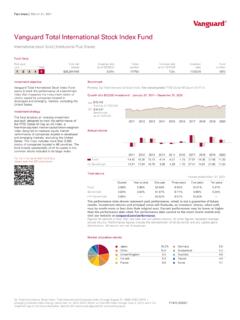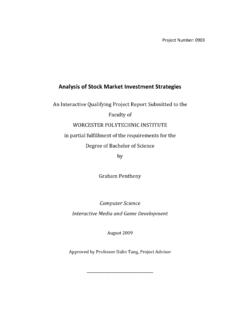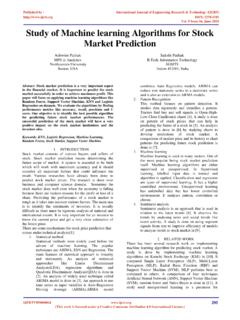Transcription of Taking Stock of China’s Semiconductor Industry
1 SIA WHITEPAPER: Taking Stock OF CHINA'S Semiconductor Industry , July 2021. SIA WHITEPAPER: Taking Stock OF. CHINA'S Semiconductor Industry . Just last month, China sent astronauts into space to board a new space station. Earlier this year, China landed a rover on Mars. Chinese state media reported that inside both China's space station and the Mars rover were 100% indigenously designed-and-produced semiconductors, signaling China's increasingly sophisticated microchip capabilities. Nevertheless, while China has mastered some chip technologies, its commercial Semiconductor Industry is still relatively nascent. Still, the Chinese government is making serious efforts to close the gap, investing well over $150 billion from 2014 through 2030 in semiconductors. Buoyed by a booming market and these government investments, China is poised to be increasingly competitive in some Semiconductor market segments.
2 In order to form a calibrated and appropriate policy response, it is important to examine China's current place in the Semiconductor supply chain, what its prospects are, and what aspects of China's Semiconductor industrial policy may pose challenges. Ultimately, the winning formula for long-term competition with China is to invest in American Semiconductor technology and to strengthen the resiliency of America's chip supply chains. I. China's Important Role in the Global Electronics Supply Chain China is the world's largest manufacturing hub, producing 36% of the world's electronics including smartphones, computers, cloud servers, and telecom infrastructure cementing the country as the largest node in the global electronics supply chain. In addition, with nearly one-fifth of the world's population, China is the second-largest final consumption market after the for electronic devices embedded with semiconductors.
3 The driving force behind these dynamics is a highly global Semiconductor and ICT supply chain, where indigenous Chinese and multinational contract electronics manufacturers based in China import semiconductors that are then assembled into tech products to be re-exported or sold in the domestic market for final consumption. To underscore this point, in 2020, China imported a whopping $378 billion in semiconductors; assembled 35% of the world's electronic devices; accounted for 30% to 70%. (depending on the product) of the global TV, PC, and mobile phone exports; and consumed one-quarter of all Semiconductor -enabled electronics. Access to this massive market is essential to the success of any globally competitive chip firm today and in the future. As a latecomer to the Semiconductor sector, the indigenous Chinese chip Industry is relatively small, accounting for only of total global Semiconductor sales.
4 Chinese chip firms primarily sell discrete semiconductors, lower-end logic chips, and analog chips to consumer, communications, and industrial Page 1. SIA WHITEPAPER: Taking Stock OF CHINA'S Semiconductor Industry , July 2021. end markets. Chinese chip firms are notably absent in the market for high-end logic, advanced analog, and leading-edge memory products. China's indigenous Semiconductor supply chain is even less developed. It lags significantly in advanced logic foundry production, EDA tools, chip design IP, Semiconductor manufacturing equipment, and Semiconductor materials. Chinese foundries currently focus on more mature nodes, and China's supply chain capabilities at the equipment and materials level are presently limited to older technologies. In the highly interconnected and layered global Semiconductor supply chain, however, China currently possesses some notable strengths.
5 It is already a global leader in outsourced assembly, packaging, and testing (OSAT). China's leading OSAT players are ranked among the top 10 OSAT companies in the world, collectively holding 38% of the total OSAT market in 2020. Chinese OSAT firms have also gone global, with more than 30% of their manufacturing facilities based outside of China. While China holds only of the market for global chip sales, this number is growing fast, and China is making significant progress thanks to a burgeoning domestic market . Chinese fabless firms and IDM. leaders have made notable progress in mid-tier mobile processors and basebands, embedded CPUs, network processors, sensors, and power device development. Chinese firms already hold an impressive 16% of the global fabless Semiconductor market in 2020, ranking third after the and Taiwan. China is also rapidly closing the gap in AI chip design, due partly to fast growing demand from China's hyperscale cloud and consumer smart device market and lower barriers to entry in chip design.
6 Chinese fabless firms are now taping out 7/5nm chip designs for everything from AI to 5G communications. China is also an important front-end wafer manufacturer. With Chinese and foreign foundries and IDMs setting up fabs to ensure proximity to customer supply-chains, approximately 23% of the global installed Page 2. SIA WHITEPAPER: Taking Stock OF CHINA'S Semiconductor Industry , July 2021. wafer capacity is currently located in China, of which 30% is owned by multinational firms primarily from other East Asian nations. While nearly 95% of installed indigenous Chinese capacity are trailing-edge nodes (>28nm), the relevance of these more mature manufacturing technologies should not be dismissed as the digital transformation of our economy accelerates demand for both old and new chips. II. Chinese Semiconductor Industrial Policy While the Chinese government has long had an industrial policy to support its nascent chip Industry , these efforts accelerated in 2014, as China released its National IC Promotion Guidelines, which laid out ambitious targets for Industry revenue, production capacity, and technological advances.
7 A year later, China published the now-controversial Made in China 2025 Plan, which sets aspirational goals for China to achieve 70% self- sufficiency in semiconductors by 2025. Central to China's Semiconductor industrial policy is the National Integrated Circuits Industry Development Investment Fund (known as the Big Fund ), established in 2014 with $21 billion in state-backed financing. The Big Fund was renewed in 2019 for a second round of state financing that exceeded $35 billion. To date, China's National IC Fund has invested $39 billion, of which has been for front-end manufacturing with the goal to increase China's share of global Semiconductor production. In addition, China has announced more than 15 local government IC funds for a total of $25 billion in dedicated to funding Chinese Semiconductor companies. Combined with the National Fund, this amounts to $73 billion which is unmatched in any other country.
8 However, this does not account for government grants, equity investments, and low-interest loans which exceeds $50 billion alone. The role of the Chinese government in supporting its own Semiconductor Industry cannot be overstated. A 2019. study by the OECD found China's four state-backed Semiconductor companies received a total of $ billion in below- market loans from China's financial institutions between 2014-2018, accounting for 98% of below- market borrowing among the 21 companies identified in the report1. In addition, across the sector, 43% of registered capital (totaling $51 billion) in the Chinese Semiconductor Industry is directly or indirectly owned or controlled by the Chinese state, indicating the significant influence the government has over the direction of its Industry . Other Chinese government incentives tailored to support its domestic Semiconductor sector include grants, reduced utility rates, favorable loans, significant tax breaks, and free or discounted land.
9 These incentives provide a significant cost advantage Page 3. SIA WHITEPAPER: Taking Stock OF CHINA'S Semiconductor Industry , July 2021. for firms in China, sometimes insulating them from market competition. In fact, a 2020 report by the Boston Consulting Group found the cost of building and operating a fab in China is 37% lower than doing so in the With increasing geopolitical tensions, China's efforts to build an indigenous supply chain gained renewed urgency over the last few years, backed at the highest political levels in Beijing. In China's newly released 14th Five-Year Plan, semiconductors were explicitly identified as a strategic technology priority, requiring a whole-of-society effort to achieve technological self-reliance. In August 2020, China further expanded its Semiconductor preferential tax policies, which include up to a 10-year corporate tax exemption for Semiconductor manufacturers, which could be valued at over $20.
10 Billion. Domestic Chinese technology companies are also stepping up efforts to push into the Semiconductor Industry . In fact, there has been a significant acceleration in the pace of investments in semiconductors. In 2020. alone, more than 22,800 new Semiconductor companies were established in China, up 195% from 2019. Forty Semiconductor companies in the supply chain are publicly traded on China's new Nasdaq-style STAR. Board. These firms collectively raised a total of $ billion during their IPOs. Page 4. SIA WHITEPAPER: Taking Stock OF CHINA'S Semiconductor Industry , July 2021. III. Progress and Challenges So far, the bulk of Chinese government subsidies have been for fab construction. Thanks to this support, Chinese firms have announced over 110 new fab projects with a total committed investment of $196 billion since 2014. But the actual amount invested is significantly lower and there have been some notable failures.















